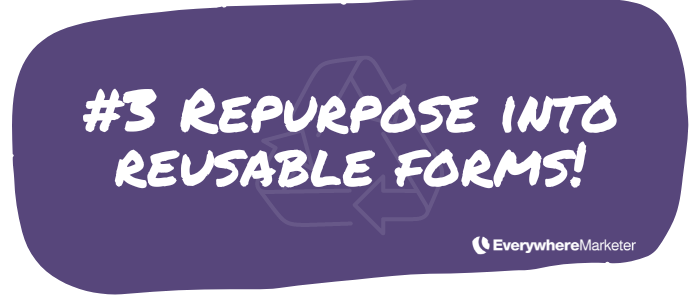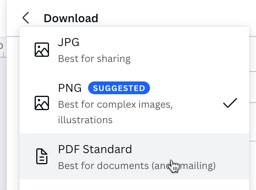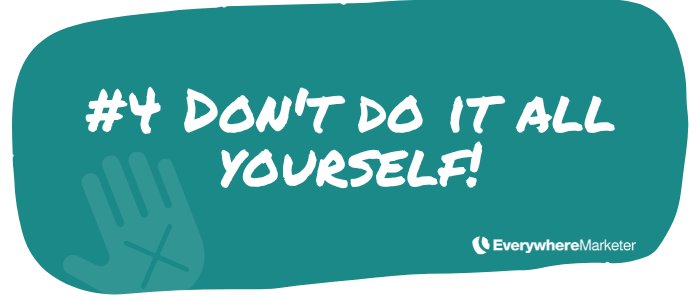Not repurposing yet?
Then you're leaving much of your content's value still on the table.
With repurposing, you multiply your reach.
You put your message in front of new audiences across multiple platforms... and all with minimal effort.
You're simply adapting existing content into new forms.
But how do you make sure you're doing so in the most efficient, effective way possible?
Follow these 5 best practices for repurposing content, and the most important one is to simply…
1. Be Consistent

Probably the most important best practice for repurposing content is to do so consistently.
You have to keep showing up.
Repurposing allows you to appear in front of new audiences across multiple platforms with relatively minimal effort.Click To Post OnMost of the repurposing advice out there suggests occasionally picking one of your top performing pieces of content, repurposing that into different forms, and effectively ignoring everything else.
Nonsense.
That’s only suggested because they’re not approaching it systematically (see #5 below to find out how to do so).
So sporadic repurposing was left as the only option, sucking up the dregs of already overstretched content marketing teams or further exhausting solopreneurs trying to tackle it all on their own.
But on nearly every platform you repurpose content to, you don’t build audiences and long-term success by showing up every now and then.
In fact, let’s be honest. Approaching it sporadically is largely a waste of time and effort.
Instead, building audiences and achieving long-term results on any content platform requires regular, consistent action.
So why is it any different just because you’re repurposing something?
It’s not.
So above all, be consistent.
And #4 and #5 below tell you how to achieve it.
What's probably the most important best practice when repurposing content? Doing so consistently. You have to keep showing up.Click To Post On2. Keep the Content on Your Own Website Unique

This relates to written content you have on your blog.
Yes, it might be easier to just do a quick copy and paste and stick the same content somewhere else.
But here’s the problem.
Let’s say you put it straight onto Medium, as is. And then Google comes along, decides to treat the Medium content as most authoritative, and prioritizes it in the search results.
That means the same content on your own blog effectively disappears from view.
(You can specify the canonical URL, but Google doesn’t always respect it).
It’s best practice to have your own blog’s content listed separately, as:
- It’s much easier to convert visitors to your own website into opt-in leads, as you have full control and can do things like show dynamic popups
- You can add retargeting codes, and show them advertising once they’ve left
In addition, by having your original blog post and a rewritten version of the content elsewhere, you’re doubling your search presence.
And it’s far easier to get an additional search listing by repurposing something via a simple rewrite, than starting a new piece of content from scratch.
Rewriting used to be a fairly onerous activity—but you can now use AI tools to help, cutting down the time it takes considerably. Here's a quick overview of 9 of the best ones:
3. Repurpose Into Reusable Forms

Even though you have the original content to work from, it still takes time (and potentially other resources) to repurpose it into a different form.
So to be as efficient as possible and extract maximum leverage from that content, best practice is to repurpose it into a form that can be reused in multiple ways or multiple places.
Here are some examples of some hyper-efficient forms of repurposed content.
Video
Video can of course be shared on YouTube, potentially Vimeo too, as well as uploaded and shared natively across multiple social platforms.
On some platforms like Instagram it can even be shared in different ways.
If the video has been created as a piece of content repurposed from a blog post, once on YouTube it can also be embedded back into that originating blog post, and maybe other posts too.
Doing so helps your SEO — in other words, helps such posts attract additional traffic from search — because:
- You’re adding additional value to the post, helping to push it up the rankings
- Visitors stay longer as videos can improve engagement levels, sending positive signals to Google
Doing so also helps to attract subscribers to your YouTube channel, building your YouTube audience for longer term benefits.
When repurposing content, be as efficient as possible by repurposing it into forms you can use in multiple ways and multiple places.Click To Post OnCarousel Images
If you’re an Instagram user, you’ve likely seen the carousel format, with multiple swipeable images within a single post.
In fact, it’s one of the most engaging formats on that platform.
The good news is that such images can be used elsewhere too, such as:
- A multi-image post on Facebook
- Similarly on X, though they only permit up to 4 images
- A PDF shared on LinkedIn - these are swipeable in a way similar to Instagram carousels, and attract high engagement. If using Canva to create your carousel images, simply choose to download as a PDF instead.

Article
Creating an article of say 1,000 to 1,500 words, whether rewritten from an original blog post or repurposed from say a video or podcast, can then be used across multiple websites, including:
- Medium—add it to a publication you’ve created yourself, or contribute it to a third-party publication
- LinkedIn’s publishing platform—articles on LinkedIn can attract a lot of views and engagement, can be listed on Google, and gain higher reach when shared on LinkedIn than when sharing a link to a third-party website
- Quora—articles can be adapted into answers to relevant questions on Quora, as well as shared via Quora Spaces, a type of blogging platform within Quora
- Guest blogs—guest blogging puts you in front of audiences that are often larger than your own and would otherwise be difficult to reach, and can boost your own authority and credibility
Remember, if repurposing from an original blog post, rewriting the content ensures the original post stays unique and remains listed on Google, while potentially doubling (or more) your search engine visibility thanks to the rewritten version.
Short Summary
Repurposing an original piece of content into a short written summary (say, 120-150 words) takes just a few minutes to do, and can then be used in a surprising number of ways, including:
- A description for a video (repurposed from the same original content) on YouTube and elsewhere, including when shared natively on social media
- As an X thread
- As the text used in a series of carousel images
- As the text in a text motion video. Here’s an example:
4. Don’t Do It All Yourself

If you’re a solopreneur or operating as a solo content marketing “team”, the biggest obstacle you’ll come up against when trying to repurpose content effectively is trying to do it all yourself.
This approach is simply never effective, because you won’t be able to achieve the consistency required (see #1 above).
Inevitably, something else that appears more pressing will come up, priorities will shift, and you may just simply not have the inclination to take care of the repurposing work that’s needed.
After all, as soon as you click publish on one piece of content, there’s that next one staring at you on the content calendar with a brand new deadline.
Unfortunately, taking care of the next piece of content rather than maximizing the value of the one just published, means ignoring up to 80% of its inherent value.
So, do yourself a favor.
Stop relying on yourself to take care of the repurposing side of things, or kidding yourself that one day you’ll get on top of it.
Ain’t gonna happen!
The biggest obstacle that will stop you from repurposing content effectively is trying to do it all yourself. Instead, hire others, and systematize your processes.Click To Post OnInstead, as soon as you hit publish, you should be able to rest easy, knowing that one or more other people are taking care of the repurposing, which you can then just monitor.
After all, much of it can be outsourced incredibly cheaply.
It’s really all about getting the right system in place so that it can, well, just happen.
Doing so will revolutionize your whole approach to repurposing content, and therefore the results you achieve from it as well.
5. Use a System

Using a system doesn’t mean you have to rush in and have everything systematized right from the start.
Just start with one way you’re going to repurpose your content, and build up from there.
See the following for starters:
However, the system you use needs to be scalable.
Sure, if you’re only repurposing it one way, then you could probably get away with a spreadsheet, and try and keep track of it that way.
But start adding more ways to repurpose, and it gets messy very quickly, becomes unmanageable, everything falls apart, and then you’re back to square one (trust me, I’ve tried!)
Instead, best practice is to use something built for purpose, and that means using the appropriate software.
Trafficonomy is specifically built to help with repurposing content effectively:
- Tasks can be automatically assigned and then monitored as needed, as soon as you publish something through your pillar content channel, such as a blog.
- It’s completely scalable, which means over time you can make your repurposing (and any other post-publication, promotional) activities as extensive as you need.
Frequently Asked Questions
What is one of the top best practices for repurposing content?
Doing so consistently. You have to keep showing up.
Why is it important to keep the content on your own website unique when repurposing?
To maintain control, increase conversions, and improve search engine visibility.
How can you repurpose content into reusable forms?
Create videos, carousel images, articles, and short summaries for versatile use.
Why shouldn't you try to handle all content repurposing tasks on your own?
Doing everything yourself can lead to inconsistency and overlook most of the content's value.
What is recommended for effective content repurposing?
Using a scalable system like Trafficonomy to manage and automate tasks.
To Conclude
This post has explored five best practices for repurposing content effectively, including ways to maximize the results you achieve from doing so while avoiding additional personal workload.
Out of all of them, the practice that’s going to have the single biggest impact on your results is to systematize your whole approach, making it scalable while helping you achieve the consistency needed to achieve long-term success from repurposing.
P.S. Don't forget about all your old content! That's perfect for repurposing too—here's a guide with 7 tips and tricks for repurposing old content.













